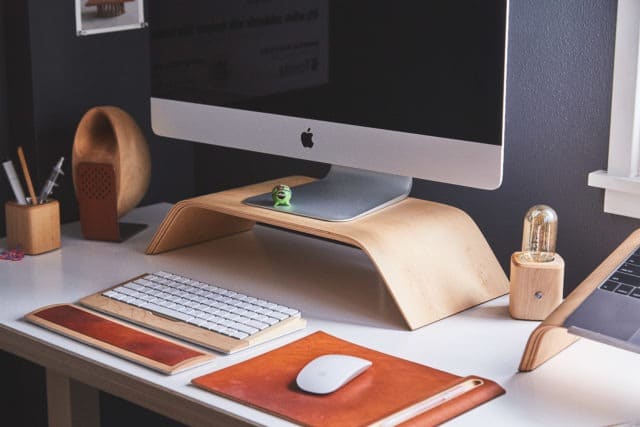Consider your morning commute. You know the route by heart, and you could probably drive it in your sleep. So when things like construction, roadblocks or detours pop up, it can be frustrating, distracting you from effectively accomplishing the task at hand.
Working in a cluttered space is a lot like driving through a city on a Friday afternoon: there will inevitably be some detours, traffic, and other things that throw you off your game and make it harder to get work done. When you spend extra time searching for materials or supplies, your workflow–and train of thought–is interrupted.
Wonderful things happen when you take the time to rethink how you organize your workspace. Decluttering and organizing your workspace means less time spent searching and more time being productive. You’ll no longer have to interrupt your train of thought/conference call to find things or be distracted by the clutter that surrounds you on any given day.
Plus, your coworkers may start to think you’re a naturally tidy person. Bonus. Just don’t flinch too hard when you realize how much time you wasted sifting through documents to find just the right printed version of that RFP.
Without further ado, let’s address those invites to last year’s holiday party that are still in your desk drawer.
How To Organize Your Desk
Tactic #1: Purge your space.
Getting started is the hardest part. Organizing your desk space starts with a total purge. Clear everything off your desk, out of your filing system, out of your drawers and cabinets, and decide what’s worth keeping and what’s worth ditching. You may end up with large piles of files and old conference swag on the floor, but the end result will be worth it.
Tactic #2: Clean your space…and keep it clean.
Now that you’ve cleared your space of clutter, you may notice all the dust that accumulated behind your stack of unused office supplies and week-old memos. Take this opportunity to give your desktop a fresh start…extra points if you use alcohol wipes or wood polish, depending.
Tactic #3: Decide what piles should stay, and which can go.
We all do it: hoarding of paper and projects. “But what if I need this later?” Trust me, you won’t. Some things are important and stand the test of time, and maybe they deserve their own folder. But temporary papers should get organized and dated, or thrown in the bin.
This may sound difficult, but it gets easier as you sort. You’ll undoubtedly find some things you may want to keep “just in case,” but have the courage to let go of the things that are no longer serving you. You’ll probably find some gems, but you can probably throw away v.1 of that project outline from Q1.
Tactic #4: Label everything (seriously, everything).
If you so choose, investing in a good labelmaker will save you all the time you waste searching for things. Whether it’s a hard copy of product map or a stapler, you don’t have time to waste searching for misplaced items. It’s easier to stay organized when you know where everything is.
The Morning Routines of 15 Successful Top Business Leaders: What Can You Learn?
Tactic #5: Designate particular spaces for particular things.
Have this in mind when labeling, and you’ll never spend time searching for items again. When it’s time to return your worthy items to your desk and drawers, you’ll know exactly where to put them all. Office supplies in this drawer, older files in this drawer, meeting files in this tray, pen cup in the corner, etc.
Tactic #6: Decide what goes in drawers and which staples stay above deck
When restocking your desk with it’s thoroughly vetted items, decide which items can be stowed away, and which ones will get daily use. I advise keeping most items out of site for a minimal, clean desk, but to each their own. Fair warning, it will get tiresome staring at those items you always hope you’ll use, but never get the chance.
Tactic #7: Get whatever desk organizer floats your boat.
There is no end to the vast cornucopia of desk organizers available at any supplies store or supercenter. Whether you go with matte, gold, or stainless steel, a desk organizer can be endlessly valuable when keeping reasonable amounts of office supplies on your desk. Some even have a file holder attached. Nifty.
Tactic #8: Rethink your filing system.
Rather than throwing files into the cabinet with reckless abandon, organize your files in the way that makes the most sense to you. That may be alphabetical, or it may be by prioritizing your projects by importance. Whatever way you do it, it only has to make sense to you.
Tactic #9: Create folders for meetings.
Create a folder that is dedicated only to meetings, whether it is collateral, presentation notes, or notes on someone else’s presentation. Having a folder dedicated solely to meeting materials means you’ll have a one-stop-shop for when you blank on next steps, or need some help preparing for a follow-up.

Tactic #10: Create folders for people/projects.
Depending on your team dynamic, create folders for projects (team environment) or people (one-on-one work). Similar to the impetus for the meeting folder, you’ll know exactly which file to pull when a team member needs a specific document related to a project.
Tactic #11: Get yourself an analog inbox.
Inboxes aren’t just for the digital world. Get an inbox tray for your desk so you always know when someone drops by with materials, even when you’re away from your desk. This also keeps messages/communications from others away from your carefully organized meeting and project papers.
Tactic #12: Separate your paper from your hardware.
This may seem like a no-brainer, but those pesky papers always find their way back into piles on your desktop. Once you have your filing system setup, designate a spot away from your computer, so that you can be fully online rather than reading last week’s notes from that meeting you didn’t need to be in in the first place.
Tactic #13: Use unlikely space.
From the window, to the wall, there is always more storage space than meets the eye. Have an unused windowsill next to your desk? Throw your pencil holder or inbox tray over there and save valuable workspace. Have some barren wall space? There are about a million ways to make a corkboard for memos or personal things you’d rather not have cluttering your desk.
Task #14: Express yourself.
Everyone is more comfortable working in a place that feels like themselves. Whether that means bringing in a select number of personal items (be sparing here), or jazzing up your office surroundings to reflect your unique personality, it’s always okay to make yourself more at home in your space. Whether you need pictures of your dog, or just some expressive office supplies…you do you.
Need some inspiration? Martha Stewart has some very fun ideas here.
Tactic #15: Make this part of a weekly routine.
Sure, it’s easy to slap a post-it on a document and say you’ll get rid of it next Tuesday. Without a schedule, your well-intentioned expiration dates will come and go with nary a calendar reminder. Be intentional about continuing to sort and discard documents once they’ve served their purpose. All these suggestions are useless without a set regimen in place.
Tactic #16: Make your own storage space.
So you’ve organized all your folders and files, and you’ve hidden all your extra belongings out of eyesight. Where do you put new additions? It’s always kosher to add an extra desk drawer for your desktop. Some desktop organizers include an extra tray or drawer under the file holder, so it doesn’t take up extra space. Like magic.
Tactic #17: Make your own personal space.
No matter how hard you try, it’s easy to let items build up during the day when you’re hard at work. Even when these temporary setbacks happen, make sure there is one thing you don’t compromise on: white space. Keep one section of your desk clear, preferably on the side of your mouse hand. That way, when it feels like the clutter is closing in, you’ll always have a little room to work.
Tactic #18: Straighten up before you go.
Use the last five minutes of your day to clear off any clutter from your desk that may have accumulated throughout the day. You don’t have to attack your monitor with a duster every night, but a simple clearing away of used coffee cups, your lunch container, any unorganized documents will help you leave your place of business with peace of mind. It’s a zen way to part from work, and it’s always nice to come in to a clean desk in the morning.
Takeaways
You may have noticed some themes in those suggestions. So, overall, what did we learn?
Takeaway #1: It’s all about the paper.
If you didn’t notice, we talked a lot about managing documents and foolproofing your filing system. Despite the increase of digital communications, extraneous papers and documents will inevitably accumulate on your desktop. They are the culprit behind most desk litter, and can make it hard to keep organized.
Organizing your papers into a filing system that resonates with you will help you know exactly where the knowledge is any time you need it. No more wasted time spent catching up on a project or panicking before an important meeting because you can’t find your notes.
Takeaway #2: Be brutal when purging and sorting.
It’s okay to pick favorites. Always be careful to keep anything you may need, but be certain you need it. And if you need it, be certain you have a place for it. Even if you get into the weeds when creating project or people folders, it will bring much more peace of mind than being surrounded by clutter and dust.
Plus, when designing your new space, you’ll be able to express yourself more with a clean environment. Whether you splurge on a fancy desk organizer, or are just happy to remove the piles of extra miscellaneous work stuff, you’ll be set up for success in your workflow. Less distractions, more space to be you without all the old stuff holding you down.
Takeaway #3: Spell it out for yourself.
Go crazy with that label maker. Label every drawer and shelf you have. There is no limit to how organized you can be with your personal space. That includes the aforementioned overly-granular categorization of documents. It’s okay to have ten folders in your brand new file holder, because you’ll know exactly where everything is when you need it. No more hindered productivity.
Takeaway #4: It may not happen all at once.
Some people relate purging and reorganizing your space to breaking off a bad relationship. I disagree. Unlike a bad relationship, where you definitely SHOULD break it off ASAP, becoming a more organized person with a more organized space can sometimes be a drawn out process.
If you have trouble enacting some of these new habits at first, don’t sweat it. Keeping a clean space can be very difficult, especially when you’re on a deadline, travel a lot for work, or have an abundance of projects that need managing. For people working remotely, I’m sure keeping your workspace clean falls in line with keeping a clean house, which is always an uphill battle. But taking a couple minutes each day to tackle at least one of these humble suggestions will provide big results in the end, and a desktop you can be proud of.




